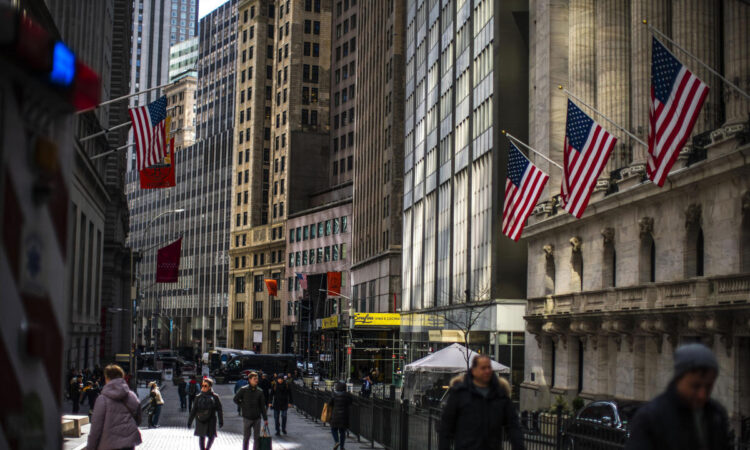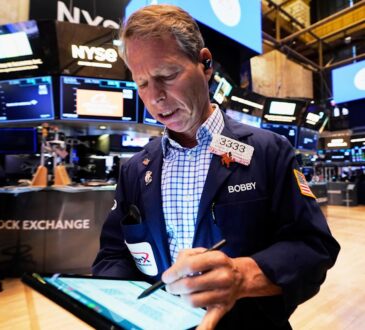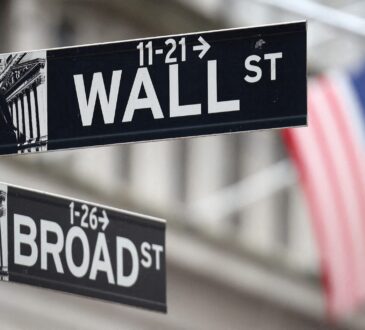
NEW YORK (AP) — U.S. stocks are ticking higher Monday after a roller-coaster end to last week left them a bit shy of their records.
The S&P 500 was 0.3% higher in midday trading, coming off a stretch where a 1.2% drop immediately flipped to a 1.1% gain. The Dow Jones Industrial Average was up 62 points, or 0.2%, as of 11 a.m. Eastern time, and the Nasdaq composite was 0.4% higher.
Much of the focus has been on interest rates and when the Federal Reserve will lower them to ease pressure on the economy and financial system. A string of reports showing inflation and the economy have remained hotter than expected has forced Wall Street to delay forecasts for when relief on rates could arrive.
This upcoming week has several flashpoints that could further swing expectations. On Wednesday will come the latest monthly update on the inflation that U.S. consumers are feeling. Later in the week will be reports on inflation at the wholesale level and expectations for upcoming inflation among U.S. households.
Fed Chair Jerome Powell said recently he still expects cuts to interest rates this year, but the central bank needs additional confirmation inflation is heading toward its target of 2%. The Fed has been holding its main interest rate at the highest level in more than two decades, hoping to grind down enough on the economy and prices for investments to get inflation under control. The risk of holding rates too high for too long is it could cause a recession.
But some Fed officials have also raised the possibility of rates staying high for longer if inflation remains stubborn. That has pushed some traders on Wall Street to cut back expectations for how many cuts to rates may arrive this year to two from three. They had already drastically pulled back their forecasts from the start of this year, when many were expecting six cuts or more.
Traders now see roughly a coin flip’s chance of the Fed cutting interest rates at its meeting in June, down from a better than 70% probability a month ago, according to data from CME Group.
Cuts to interest rates not only make borrowing easier for U.S. households and companies, they also encourage investors to pay higher prices for stocks and other investments. Stock prices have already leaped in part on such expectations.
U.S. stocks have remained near records despite the diminishing chances of rate cuts this year because of the hope that the strong economy will drive profits for companies. Profits and interest rates are the two main levers that set stock prices.
Such hopes have helped the stock market’s gains broaden out beyond the handful of Big Tech stocks responsible for the majority of last year’s gain. Energy producers in the S&P 500 have jumped roughly 16.5% this year, after dropping nearly 5% last year, on expectations that the recent rebound in energy prices will mean fatter profits in the future.
It’s also possible that the U.S. economy can continue to post both strong growth while inflation cools. That’s what Goldman Sachs economist David Mericle is forecasting, in part because of elevated immigration of younger people who are working in construction and other industries that generally earn lower wages.
Friday’s surprisingly strong jobs report showed that workers’ average hourly wages were behaving as expected, even though employers hired far more workers than expected last month.
But critics say stock prices already look expensive given their huge run of more than 20% from November into March. That means “achieving ambitious earnings forecasts has become paramount,” according to Lisa Shalett, chief investment officer at Morgan Stanley Wealth Management.
“Economic growth is good, but complacency around its implications is not,” she said.
To that end, this week will bring the start of the latest earnings reporting season. Delta Air Lines, JPMorgan Chase and other banks will headline the earliest days of the reporting period. Analysts are expecting companies across the S&P 500 to deliver a third straight quarter of growth from the prior year.
JPMorgan Chase added 0.6% after CEO Jamie Dimon, the nation’s most influential banker, told investors he continues to expect the U.S. economy to grow this year. But he worries the war in Ukraine, the Israel-Hamas war and U.S. political polarization might be creating an environment that “may very well be creating risks that could eclipse anything since World War II.”
He also said stock prices broadly look to be “at the high end of the valuation range,” a way of saying they could appear expensive. And he said his bank is preparing for a wide range of possibilities on interest rates, “from 2% to 8% or even more,” given uncertainty about where inflation and the economy are heading.
U.S.-traded shares of Taiwan Semiconductor Manufacturing Co. rose 2.6% after the Biden administration pledged to provide up to $6.6 billion so that it can expand the facilities it is already building in Arizona and better ensure that the most advanced microchips are produced domestically for the first time.
In the bond market, Treasury yields were rising to add to their gains for the year so far on diminished expectations for cuts to rates. The yield on the 10-year Treasury ticked up to 4.43% from 4.40% late Friday and less than 3.90% at the start of the year.
In stock markets abroad, indexes mostly rose across Europe and Asia, though stocks fell 0.7% in Shanghai.
___
AP Business Writers Matt Ott and Yuri Kageyama contributed.




